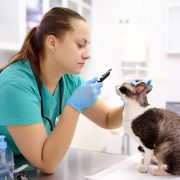Evidence of exposure to SARS-CoV-2 in cats and dogs from households in Italy
Evidence of exposure to SARS-CoV-2 in cats and dogs from households in Italy
Published 28 July 2020
Patterson, E.I. (2020) Evidence of exposure to SARS-CoV-2 in cats and dogs from households in Italy. Nature Communications, 11, no. 6231. https://doi.org/10.1038/s41467-020-20097-0
This paper reports on an epidemiological survey to assess SARS-CoV-2 infection in 817 dogs and cats, living in northern Italy and sampled between March and May 2020, at a time of frequent human infection.
A total of 540 dogs and 277 cats were sampled from different Italian regions, mostly Lombardy (476 dogs, 187 cats). All animals were sampled by their private veterinary surgeon during routine healthcare visits and a range of samples were taken:
- Oropharyngeal swabs (306 dogs, 175 cats),
- nasal swabs (185 dogs, 77 cats),
- rectal swabs (66 dogs, 30 cats)
For 340 dogs and 188 cats, full signalment and clinical history were available, including breed, sex, age, exposure to COVID-19 infected humans, and presence of respiratory signs.
Sera were available for 188 dogs and 63 cats for which complete signalment, history and location were available. Additional sera were collected from diagnostic laboratories for 200 dogs and 89 cats from the affected areas, but which lacked further historical information.
No animals tested PCR positive. However, 3.4% of dogs and 3.9% of cats had measurable SARS-CoV-2 neutralizing antibody titres, ranging from 1:20 to 1:160 in dogs and from 1:40 to 1:1280 in cat.
Dogs from COVID-19 positive households being significantly more likely to test positive than those from COVID-19 negative households.
Although this is a large survey it should be noted that not all information was available for all animals, and that lack of confirmed COVID infection in the household does not mean that no-one was infected. However, it does appear to demonstrate that both cats and dogs can seroconvert under the normal conditions of pet ownership, at least where the burden of disease is high in humans.






Leave a Reply
Want to join the discussion?Feel free to contribute!